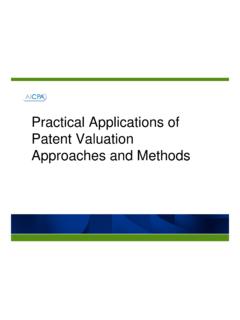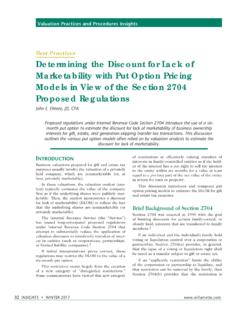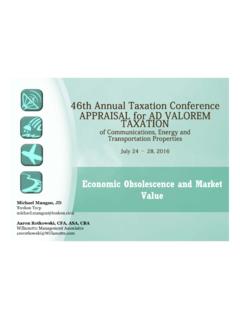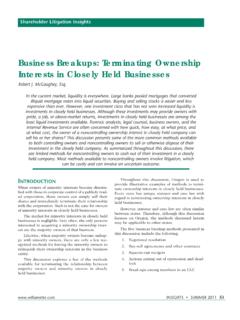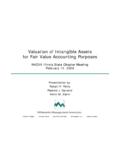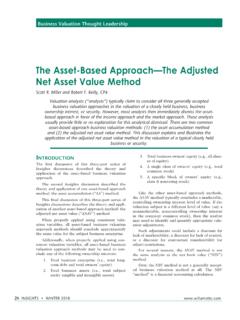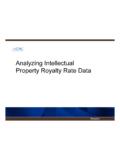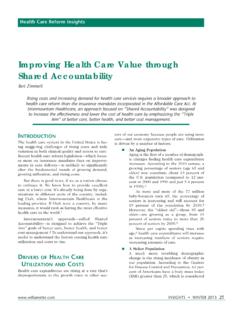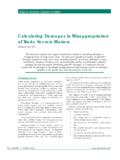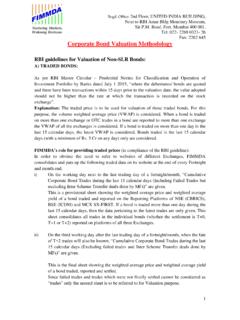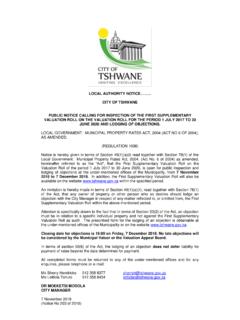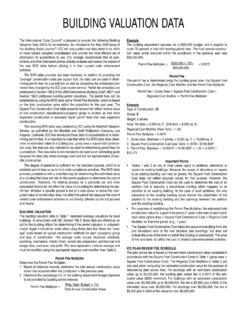Transcription of Intangible Asset Valuation – Cost Approach …
1 Intangible Asset Valuation . cost Approach methods and procedures Presentation to the Business Valuation Association Chicago, Illinois Thursday, September 20, 2012. Presentation by Robert F. Reilly, CPA. Managing Director Chicago, Illinois Portland, Oregon Chicago, Illinois Atlanta, Georgia Discussion Outline Introduction Reasons to Value Intangible Assets Common Types of Intangible Assets Common Types of Health Care Intangible Assets Generally Accepted Intangible Asset Valuation Approaches Valuation Process Data Gathering and Due Diligence Reasons to Use the cost Approach cost Approach Valuation methods cost Measurement procedures Remaining Useful Life Considerations Physical Depreciation Measurement procedures Functional Obsolescence Measurement procedures Economic Obsolescence Measurement procedures Concluding the Value Indication Defending the Value Indication Summary and Conclusion Willamette Management Associates 1.
2 Introduction There is a diversity of practice among analysts regarding the use of the cost Approach to value Intangible assets This diversity of practice encompasses: 1. when to use the cost Approach 2. how to apply the cost Approach 3. how to interpret the cost Approach value indication This diversity is particularly evident in Intangible Asset valuations prepared for financial accounting purposes ( , acquisition accounting, goodwill, and long-lived Asset impairment). Willamette Management Associates 2. Introduction (cont.). This diversity is also apparent in Intangible Asset valuations performed as a component of a business Valuation prepared for regulatory compliance purposes. In particular, such valuations are performed to attest to the fair market value (FMV) of a health care entity transferred between a for-profit entity and a not-for-profit entity.
3 To comply with various statutory and regulatory requirements: 1. a for-profit entity cannot pay less than FMV for a not-for-profit entity 2. a not-for-profit entity cannot sell for less than FMV to a for-profit entity Analysts often use the Asset -based Valuation Approach to assess this FMV test. Analysts often use the cost Approach to value the to-be-transferred health care entity Intangible assets. Willamette Management Associates 3. Introduction (cont.). The American Institute of Certified Public Accountants (AICPA) addressed this diversity concern by preparing a white paper regarding the use of the cost Approach to value Intangible assets. A draft of this white paper is currently exposed for comments. This presentation summarizes the contents of this AICPA. white paper on the application of the cost Approach to value Intangible assets.
4 Most analysts are familiar with income Approach Intangible Asset Valuation methods , including the multiperiod excess earnings method (MEEM) and others. Many analysts are familiar with market Approach Intangible Asset Valuation methods , including the relief from royalty method and others. Willamette Management Associates 4. Introduction (cont.). Fewer analysts are familiar with cost Approach Intangible Asset Valuation methods . In comparison, real estate and tangible personal property appraisers have more experience and training in the application of cost Approach Valuation methods . In many circumstances, the cost Approach is particularly applicable to the Valuation of certain Intangible assets. This discussion will not focus exclusively (or even primarily). on fair value accounting valuations. Fair value is one of the standards of value considered in this discussion.
5 This discussion considers the application of the cost Approach across alternative standards of value and for alternative Valuation purposes. Willamette Management Associates 5. Introduction (cont.). The illustrative examples primarily relate to the Valuation of Intangible assets within a health care entity merger and acquisition transaction. The examples involve estimating the FMV of Intangible assets for regulatory compliance purposes. Willamette Management Associates 6. Reasons to Value Intangible Assets Transaction pricing and structuring 1. pricing the arm's-length sale of an individual Intangible Asset or a portfolio of two or more Intangible assets. 2. pricing the arm's-length license of an individual Intangible Asset or a portfolio of two or more Intangible assets. 3. calculating an exchange ratio between two owners for two respective Intangible Asset portfolios.
6 4. measuring the equity allocations in a new business enterprise or joint venture when one or more parties contribute Intangible assets. 5. measuring the Asset distributions in a liquidating business enterprise or joint venture when one or more of the parties receive Intangible assets. 6. pricing the transfer of an Intangible Asset between two wholly- owned subsidiaries (or between two unequally-owned subsidiaries) of a consolidated business enterprise. Willamette Management Associates 7. Reasons to Value Intangible Assets (cont.). Financing collateralization and securitization 1. using an Intangible Asset as the collateral in either a cash flow-based or an Asset -based debt financing. 2. arranging the sale/licenseback financing of a commercial Intangible Asset . Willamette Management Associates 8. Reasons to Value Intangible Assets (cont.)
7 Taxation planning and compliance 1. forming an Intangible Asset holding company and structuring the intercompany Intangible Asset license to the taxpayer's operating companies 2. performing income tax basis purchase price allocations (among the acquired tangible assets and Intangible assets) in a taxable business acquisition ( , a Section 1060 Asset acquisition). 3. quantifying the amortization deduction for a purchased Section 197 Intangible Asset . 4. valuing Intangible assets in the taxpayer corporation insolvency exemption (Section 108) related to cancellation of debt (COD) income recognition. 5. valuing corporation Intangible assets related to built-in gain (BIG) tax deferral upon the taxpayer election to convert from C corporation to S corporation. 6. supporting the charitable contribution deduction for a donated Intangible Asset .
8 Willamette Management Associates 9. Reasons to Value Intangible Assets (cont.). Taxation planning and compliance (cont.). 7. estimating the arm's-length price (ALP) for the cross border transfer and use of a multinational taxpayer corporation's Intangible Asset (Section 482 compliance). 8. complying with state and local ad valorem property taxation of either taxable or tax exempt Intangible assets. 9. defending against IRS allegations of private inurement, excess benefits, or intermediate sanctions with regard to Intangible Asset transfers between a for-profit entity and a not-for-profit entity. Willamette Management Associates 10. Reasons to Value Intangible Assets (cont.). Regulatory compliance and corporate governance 1. estimating the fair market value estimation of the Intangible Asset sale, license, or other transfer between a for-profit entity and a not-for-profit entity 2.
9 Performing the fair market value ( Asset -based Approach ). Valuation of a going concern business enterprise to be sold between a for-profit entity and a not-for-profit entity). 3. documenting the custodial inventory and management of owned and licensed Intangible assets. 4. assessing the adequate insurance coverage for owned and licensed Intangible assets. 5. defending against infringement, misappropriation, diversion, other torts, breach of contract, and other wrongful acts to Intangible assets. 6. defending against allegations of dissipation of corporate assets. Willamette Management Associates 11. Reasons to Value Intangible Assets (cont.). Bankruptcy and reorganization 1. valuing an Intangible Asset that is pledged as collateral for secured creditor financing. 2. using an Intangible Asset as collateral for debtor in possession (DIP) secured financing.
10 3. opining on the fairness (to creditors) of the sale or license of an Intangible Asset as a DIP cash generation spinoff opportunity. 4. valuing an Intangible Asset in the performance of the debtor corporation solvency or insolvency tests (particularly the balance sheet test) with respect to fraudulent transfer claims and preference actions. 5. measuring the impact of the Intangible assets on the plan of reorganization of the bankrupt owner/operator. Willamette Management Associates 12. Reasons to Value Intangible Assets (cont.). Financial accounting and fair value reporting 1. preparing the acquisition accounting ( , transaction purchase price) allocation among acquired tangible assets and Intangible assets. 2. testing for goodwill impairment and for other Intangible Asset impairment. 3. preparing the post-bankruptcy fresh start accounting for the emerging entity tangible assets and Intangible assets.
